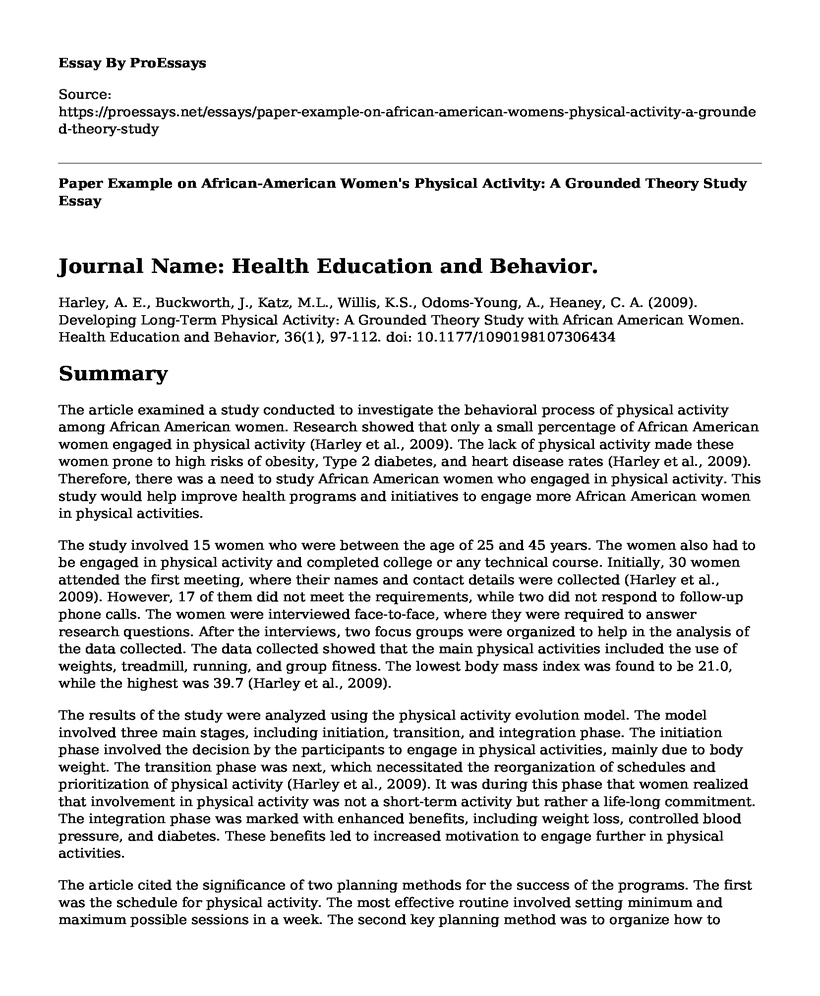Journal Name: Health Education and Behavior.
Harley, A. E., Buckworth, J., Katz, M.L., Willis, K.S., Odoms-Young, A., Heaney, C. A. (2009). Developing Long-Term Physical Activity: A Grounded Theory Study with African American Women. Health Education and Behavior, 36(1), 97-112. doi: 10.1177/1090198107306434
Summary
The article examined a study conducted to investigate the behavioral process of physical activity among African American women. Research showed that only a small percentage of African American women engaged in physical activity (Harley et al., 2009). The lack of physical activity made these women prone to high risks of obesity, Type 2 diabetes, and heart disease rates (Harley et al., 2009). Therefore, there was a need to study African American women who engaged in physical activity. This study would help improve health programs and initiatives to engage more African American women in physical activities.
The study involved 15 women who were between the age of 25 and 45 years. The women also had to be engaged in physical activity and completed college or any technical course. Initially, 30 women attended the first meeting, where their names and contact details were collected (Harley et al., 2009). However, 17 of them did not meet the requirements, while two did not respond to follow-up phone calls. The women were interviewed face-to-face, where they were required to answer research questions. After the interviews, two focus groups were organized to help in the analysis of the data collected. The data collected showed that the main physical activities included the use of weights, treadmill, running, and group fitness. The lowest body mass index was found to be 21.0, while the highest was 39.7 (Harley et al., 2009).
The results of the study were analyzed using the physical activity evolution model. The model involved three main stages, including initiation, transition, and integration phase. The initiation phase involved the decision by the participants to engage in physical activities, mainly due to body weight. The transition phase was next, which necessitated the reorganization of schedules and prioritization of physical activity (Harley et al., 2009). It was during this phase that women realized that involvement in physical activity was not a short-term activity but rather a life-long commitment. The integration phase was marked with enhanced benefits, including weight loss, controlled blood pressure, and diabetes. These benefits led to increased motivation to engage further in physical activities.
The article cited the significance of two planning methods for the success of the programs. The first was the schedule for physical activity. The most effective routine involved setting minimum and maximum possible sessions in a week. The second key planning method was to organize how to make up for lost sessions by having longer sessions, doing other activities such as walking around the block and using a rest day to engage in physical activity.
The study had two main limitations. The first was the lack of guaranteed credibility and dependability with different investigators reporting varying findings. Another shortcoming was selection bias with the number cut from 30 in the screening period to 15 (Harley et al., 2009).
In conclusion, the article argued that African American women would engage in physical activity if certain conditions were met. First, the programs had to be tailored to meet individual needs. Participants were driven by the benefits, and if programs ensured the women achieved the set goals, then more would engage in physical activity. Finally, the women had to learn how to adapt to changes and handle obstacles.
Personal Response
The article involved a study designed to find out what motivated women to engage in physical activity. The study was well conducted with control measures to ensure its limitations did not impact negatively on the results. However, the sample size was too small. The study involved only 15 women from two sorority alumni groups. The small number is a challenge since generalization of the results is inaccurate. Instead, participants should have been taken from different towns and backgrounds to increase the generalizability of the results. Overall, the results were satisfactory, showing the importance of planning to the success of the programs.
Cite this page
Paper Example on African-American Women's Physical Activity: A Grounded Theory Study. (2023, Feb 20). Retrieved from https://proessays.net/essays/paper-example-on-african-american-womens-physical-activity-a-grounded-theory-study
If you are the original author of this essay and no longer wish to have it published on the ProEssays website, please click below to request its removal:
- Medical Technology Essay
- Is It Morally Permissible for Physicians to Assist in a Suicide? Essay
- Functional Health Pattern Analysis Worksheet Paper Example
- The Bhopal Incident Essay Example
- 1982 Tylenol Crisis: Johnson & Johnson's Fight for Survival - Essay Sample
- Maternal Time & Child-Rearing: Impact on Women & Men - Essay Sample
- Essay Example on Leukemia: A Cancer of Uncontrolled White Blood Cells







